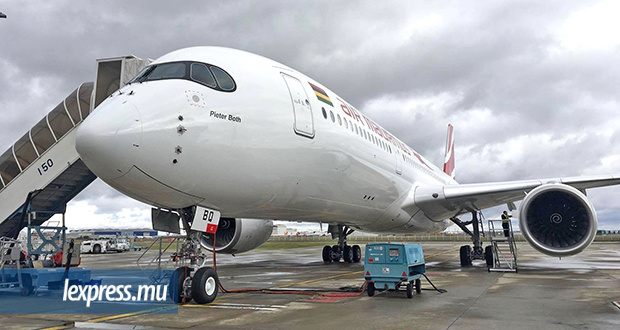Publicité
A350-900: The future of Air Mauritius
Par
Partager cet article
A350-900: The future of Air Mauritius

The Pavlovian response to travelling by Air Mauritius is limited to complaining about the lack of comfort, the below par entertainment and the food, which is anything but palatable. There is also the red herring of the political clout that the government seems to have on our national airline. Any opinion contrary to that is considered heresy. With more access and an improved fleet, there is hope that Air Mauritius can eventually dispel the omertà surrounding the company.
Key people from Air Mauritius, including CEO Somas Appavou, accompanied by more than a dozen local journalists, headed to Toulouse last week to take delivery of the “Pieter Both”, the second A350-900 XWB in its fleet. The name is a tribute to one of the most prominent mountains in the Mauritian landscape. At face value, this had the making of a routine event, like hundreds of others than journalists have to scurry through in a year. It turned out to be slightly different.
The host, Airbus, was at our beck and call from the first minute to the last. There was a degree of surprise among the journalist core, given the information that was already available to us. In a small briefing ahead of the flight to Toulouse, Prem Sewpaul, vice president communications and corporate affairs at Air Mauritius, explained that we actually have an order for eight planes from Airbus.
After the acquisition of the two A350-900 in 2017, Air Mauritius will acquire two more of the same model in 2019 and 2023. The national airline company will also renew its fleet with two A330neo next year, hence bringing the total to eight new planes from Airbus over the next few years. Air Mauritius already made the order so there was no need for the pitch, but we still got it.
Airbus has 858 firm orders from 45 different customers for the A350-900. These clients range from Air Mauritius, Air France, American Airlines, Cathay Pacific to the airline with the biggest A350-900 fleet, Qatar Airways. At a cost of over $310 million per plane, it represents a significant investment for any airline. As the first A350-900 operator based in the Indian Ocean, Air Mauritius was perceived as a potential big fish. By 2023, half of its fleet will be fresh but the other half will also need upgrading at one point. Airbus dreamed big and even pitched the A380, arguably the best airplane on the market but also the most expensive, and gave the journalists an extensive visit of its assembly line. This might not be in the medium-term plans of Air Mauritius but Airbus certainly thought it was worth mentioning as a potential future investment. For now, we’ll have to stick to the perfectly suitable A350-900.
The technical advantages of the A350-900 offer a perfect segue from the previous fleet of Air Mauritius. According to François Obé, A350 XWB marketing director, the plane is a big step for any airline. “It has an operational reliability of 99%, which is considered the Holy Grail in aviation,” said Obé. The presence of titanium and composite (carbon fibre reinforced polymer) in the materials also guarantee that there is no corrosion, which is crucial for Air Mauritius given that it has to deal with a marine airport. The 25% savings on fuel burn, CO2 emissions and cash operating cost reinforces the position of the plane as an elite product.
Taking into consideration the recent issues with pilots that Air Mauritius has faced, the pilot commonality of the plane adds another plus. There are only eight days of training required for pilots to fly the A350-900 if they have flown the A330 before. Between the A330 and the A330neo, the training only lasts about half a day.
With all of that information in mind, the journalists were paraded to the inaugural flight of the Pieter Both from the Airbus Delivery Centre in Toulouse to Mauritius via Paris. The luxurious interior, modelled on the Airspace cabin, was an instant hit. “With this product, we will be able to match our most ferocious competitors,” said Appavou, visibly happy with this new acquisition. He even played the part of a flight attendant for the dozen of journalists present by serving them drinks and snacks. “This is how you welcome people when they come to your house.”
The Wi-Fi connectivity, the vertical sidewalls, the unique flat floor, the ambient lighting and the increased legroom contributed to the defining spirit of an extremely enjoyable flight. The service was excellent, the food was much better and the entertainment – now being brandished around on Full HD screens – had something for everyone, from Bob Dylan to Désiré François.
After a little more than 10 hours of flight, the sparsely-filled inaugural flight landed in Mauritius on a bright Sunday morning and nobody was breaking a sweat. The satisfaction was tangible for all those involved. Appavou was hanging out with the pilots in the cockpit, congratulating them on a job well done. The cabin crew was all smiles, fully aware of the seminal moment they had been allowed to be a part of.
There is no doubt that the proletariat cares little about the esoteric nature of the details on the technological prowess of the A350-900. Regardless of all other issues that have plagued Air Mauritius in recent weeks, future customers will be delighted to know that the national airline company is looking towards the future.
Publicité
Publicité
Les plus récents






